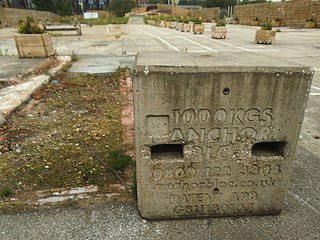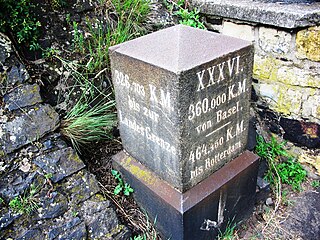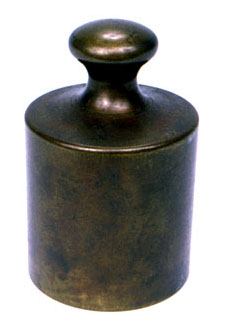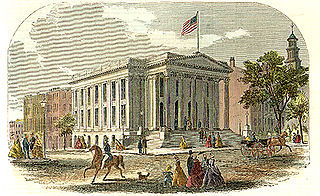
The kilogram is the unit of mass in the International System of Units (SI), having the unit symbol kg. It is a widely used measure in science, engineering and commerce worldwide, and is often simply called a kilo colloquially. It means 'one thousand grams'.

The litre or liter is a metric unit of volume. It is equal to 1 cubic decimetre (dm3), 1000 cubic centimetres (cm3) or 0.001 cubic metre (m3). A cubic decimetre occupies a volume of 10 cm × 10 cm × 10 cm and is thus equal to one-thousandth of a cubic metre.

The pound or pound-mass is a unit of mass used in British imperial and United States customary systems of measurement. Various definitions have been used; the most common today is the international avoirdupois pound, which is legally defined as exactly 0.45359237 kilograms, and which is divided into 16 avoirdupois ounces. The international standard symbol for the avoirdupois pound is lb; an alternative symbol is lbm, #, and ℔ or ″̶.
The International System of Units, known by the international abbreviation SI in all languages and sometimes pleonastically as the SI system, is the modern form of the metric system and the world's most widely used system of measurement. Established and maintained by the General Conference on Weights and Measures (CGPM), it is the only system of measurement with an official status in nearly every country in the world, employed in science, technology, industry, and everyday commerce.
A metric prefix is a unit prefix that precedes a basic unit of measure to indicate a multiple or submultiple of the unit. All metric prefixes used today are decadic. Each prefix has a unique symbol that is prepended to any unit symbol. The prefix kilo-, for example, may be added to gram to indicate multiplication by one thousand: one kilogram is equal to one thousand grams. The prefix milli-, likewise, may be added to metre to indicate division by one thousand; one millimetre is equal to one thousandth of a metre.

Ton is the name of any one of several units of measure. It has a long history and has acquired several meanings and uses.

The tonne is a unit of mass equal to 1000 kilograms. It is a non-SI unit accepted for use with SI. It is also referred to as a metric ton to distinguish it from the non-metric units of the short ton, and the long ton. It is equivalent to approximately 2204.6 pounds, 1.102 short tons, and 0.984 long tons. The official SI unit is the megagram, a less common way to express the same mass.

The metric system is a system of measurement that succeeded the decimalised system based on the metre that had been introduced in France in the 1790s. The historical development of these systems culminated in the definition of the International System of Units (SI) in the mid-20th century, under the oversight of an international standards body. Adopting the metric system is known as metrication.

The gram is a unit of mass in the International System of Units (SI) equal to one one thousandth of a kilogram.

Chinese units of measurement, known in Chinese as the shìzhì, are the traditional units of measurement of the Han Chinese. Although Chinese numerals have been decimal (base-10) since the Shang, several Chinese measures use hexadecimal (base-16). Local applications have varied, but the Chinese dynasties usually proclaimed standard measurements and recorded their predecessor's systems in their histories.
The quintal or centner is a historical unit of mass in many countries which is usually defined as 100 base units, such as pounds or kilograms. It is a traditional unit of weight in France, Portugal, and Spain and their former colonies. It is commonly used for grain prices in wholesale markets in Ethiopia and India, where 1 quintal = 100 kg.
The kilogram-force, or kilopond, is a non-standard gravitational metric unit of force. It does not comply with the International System of Units (SI) and is deprecated for most uses. The kilogram-force is equal to the magnitude of the force exerted on one kilogram of mass in a 9.80665 m/s2 gravitational field. That is, it is the weight of a kilogram under standard gravity. Therefore, one kilogram-force is by definition equal to 9.80665 N. Similarly, a gram-force is 9.80665 mN, and a milligram-force is 9.80665 μN.

Myria- (symbol my) is a now obsolete decimal metric prefix denoting a factor of 104 (ten thousand). It originates from the Greek μύριοι (mýrioi) (myriad). The prefix was part of the original metric system adopted by France in 1795, but was not adopted when the SI prefixes were internationally adopted by the 11th CGPM conference in 1960.
The gravitational metric system is a non-standard system of units, which does not comply with the International System of Units (SI). It is built on the three base quantities length, time and force with base units metre, second and kilopond respectively. Internationally used abbreviations of the system are MKpS, MKfS or MKS . However, the abbreviation MKS is also used for the MKS system of units, which, like the SI, uses mass in kilogram as a base unit.

The grave, abbreviated gv, is the unit of mass used in the first metric system which was implemented in France in 1793. In 1795, the grave was renamed as the kilogram.

The hectare is a non-SI metric unit of area equal to a square with 100-metre sides (1 hm2), or 10,000 m2, and is primarily used in the measurement of land. There are 100 hectares in one square kilometre. An acre is about 0.405 hectares and one hectare contains about 2.47 acres.

The imperial and US customary measurement systems are both derived from an earlier English system of measurement which in turn can be traced back to Ancient Roman units of measurement, and Carolingian and Saxon units of measure.
The myriagram is a former French and metric unit of mass equal to 10,000 grams. Although never as widely used as the kilogram, the myriagram was employed during the 19th century as a replacement for the earlier American customary system quarter, which was equal to 25 pounds (11,340 g).
Before it adopted the metric system in 1816, the area that now constitutes Belgium used a number of units of measurement to measure different types of quantities including length, mass, and area. Since 1820, the International Metric System has been compulsory in Belgium. Initially, different names were used for units like metre, litre, kilogram, etc.












